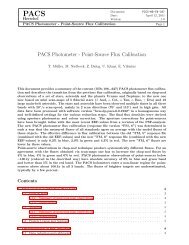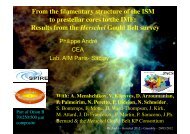Modelling planet-forming circumstellar discs - Herschel
Modelling planet-forming circumstellar discs - Herschel
Modelling planet-forming circumstellar discs - Herschel
You also want an ePaper? Increase the reach of your titles
YUMPU automatically turns print PDFs into web optimized ePapers that Google loves.
dni<br />
dt<br />
= �<br />
r<br />
Chemistry<br />
nknlR r<br />
kl→ij(Tgas) − ni<br />
�<br />
r<br />
njR r<br />
ij→kl(Tgas) ± ...<br />
elements: ∼10 e.g. H, He, C, N, O, Ne, Na, Mg, Si, S, Ar, Fe, PAHs<br />
species: ∼100 atoms, ions, double ions, molecules, vib. exc. H⋆ 2, ices, PAHs<br />
reactions: ∼1000 gas-phase, including 3-body (UMIST 2006),<br />
UV-photo-reactions with detailed σ(ν) (Leiden database),<br />
2-directional self-shielding by H2, CO, C (various papers),<br />
X-ray primary and secondary (Meijerink & Glassgold 2008)<br />
H2 formation of grain surfaces (e.g. Cazaux & Tielens 2010)<br />
H⋆ 2 chemistry (Tielens & Hollenbach 1985)<br />
ice formation (H2O # , CO # , CO #<br />
2 , CH# 4 , ...) (Aikawa 1996)<br />
(including thermal, UV-photo, and cosmic-ray desorption)<br />
PAH photo-ionisation, recomb. (Draine & Li 2007, ...)<br />
dni<br />
dt<br />
= 0 ⇒ “kinetic chemical equilibrium”<br />
• dependent on dust properties (total surface area, Tdust)<br />
• coupled to radiative transfer results (UV, X-rays)<br />
• new: more ices, simple surface chemistry (Kamp et al. 2012, in prep.)<br />
• open issues: warm and dense chemistry?<br />
•First •Prev •Next •Last •Go Back •Full Screen •Close •Quit





